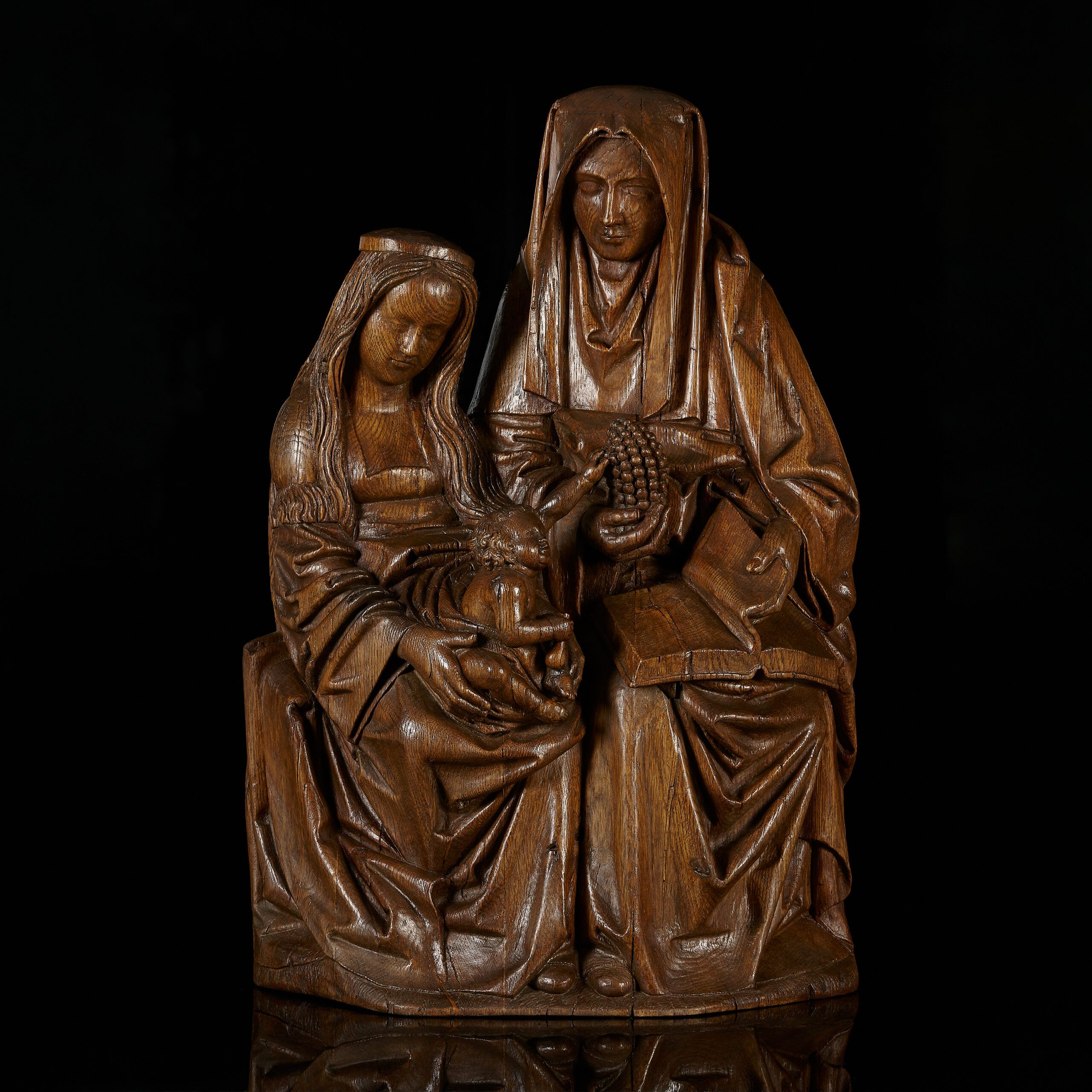Active in Antwerp ca. 1473-1509
Saint Anne Selbdritt
Oak | Carved in high relief
H. 85 cm.
PROVENANCE
Private collection, The Netherlands
Anonymous sale | Christie’s | Amsterdam | 23 March 1983 | Lot 228 | With ill.
With Limburg Antiquairs | Brouwershaven, Zierikzee and Düsseldorf | 1983/4
Private collection | Antwerp
LITERATURE
Stuurman-Aalbers, J & Stuurman, R. (1983). Internationaal Jaarboek Kunst en Antiek Veilingopbrengsten 1982. Utrecht/Antwerp: Spectrum, p. 180, nr. 8, with ill.
Tableau (Dec. 1983/Jan. 1984). As Nether Rhine ca. 1500, with ill.
Engelen, C. (1993). Jan Mertens en de laatgotiek. Confrontatie met Jan Borreman. Essay tot inzicht en overzicht van de laatgotiek. Leuven, p. 121, with ill. (chapeter VII, Sint-Anna-Ten-Drieën, pp. 119-127)
REFERENCE LITERATURE
Catalogue BRAFA, 2005, p. 362
CATALOGUE NOTE
This impressive oak group represents Saint Anne seated on a bench, turning the pages of an open book, he main iconographic attribute, with her left hand. In her right hand is holds a bunch of grapes, the symbol of the Sacramental wine and the blood of Christ. The Virgin, who sits to Anne’s right, holds the naked Christ Child on her lap. She is depicted with floating long hair on which she wears a crown. In his right hand the infant Christ holds a pear and with his left hand he reaches out to grasps held by his grandmother. Notable is the elegance and harmony of the composition of the group and the deeply varved folds of the draperies. The reverse of this sculpture is hollowed out. This, together with its size and in comparison with other examples, suggest that this group would probably originally have been enclosed within an altarpiece.
The sculpture relates to a group of Saint Anne sculptures made by Jan Mertens and his Antwerp workshop at the end of the 15th century. Most notable if the Saint Anne sculpture which is part of the rich heritage of the Church of Saint Leonard in Zoutleeuw in Belgium. This group – H. 90, carved out of oak and retaining its original polychrome and gilding – was commissioned from Jan Mertens by the church of Zoutleeuw in 1489, together with two other sculptures. Jan Mertens was paid in 1490. A very mimular Saint Anne – H. 60 cm., carved out of oak with later polychrome – is kept in the Church of Saint Willibrord in Eisden in the Netherlands. Engelen discovered the Antwerp hand-mark on the base of both groups (Engelen, 1993, pp. 115-116). Other unmarked examples of oak Saint Anne sculptures attributable to Jan Mertens and his workshop can be found in the churches of Oosthoven in the province of Limburg in Belgium (Engelen, 1993, pp. 116-117), Fronville te Hotton in the province of Luxembourg in Belgium (Engelen, 1993, p. 118) and Viex-Bourg/Lothey in the department of Brittany in north-western France (Engelen, 1993, pp. 120-121). Engelen mentions the present sculpture together with another Saint Anne group kept in a private collection (Engelen, 1993, pp. 121-122), which was exhibited by Jan Roelofs Antiquairs at BRAFA in 2005 (catalogue BRAFA, 2005, p. 362). Our group was sold at Christie’s in Amsterdam on 23 March 1983 as lot 228 as ‘possibly Flemish, 16th century, with later polychrome’. It was bought by Limburg Antiquairs who had the later polychrome roemoved. At this time the attribution to Jan Mertens was still unknown. In 1984 the group was sold to a private collection in Antwerp as ‘Lower-Rhine, ca. 1500’ and has not been on the market until now.
The South Netherlandish sculptor Jan Mertens the Elder led a workshop in Antwerp between ca. 1473 and 1504. His work is still late gothic is style but already shows elements of the early Renaissance. According to the RKD Jan Gielisz. Mertens the Elder, whose family is thought to have originated in Tournai, was the son of Gillis Mertens – who as active as ‘platijnmaker’, a crafstman specilised in (wooden) shoes – and Lysbeth de Vos. The was the brother of Wouter Gielisz. Mertens. Jan married to Lysbeth Jansdochter Janssens. He became a master sculptor in the Guild of St. Luke of Antwerp in 1473 and its dean in the years 1478, 1481 and 1487. On 30 January 1492 his daughter Katline married Gheert van Bavele. In 1489 and 1490 he worked for the Church of Saint Leonard in Zoutleeuw and in 1492 and 1493 for the Antwerp Cathedral. On 13 August 1495 he delivered an altar for the Church of Our Lady in Wouw. On 6 June 1497 the church masters of Scephout in the Meierij of ‘s-Hertogenbosch declare that they owe Jan Martens, sculptor, 15 Flemish Guilders for an altar table of the Holy Cross with the 7 Sacraments he delivered and which they have received. Jan Mertens died between 1503 and 1504, as on 7 February 1503 he still signed a deed of sales and in 1504 Lysbeth Jansdochter is mentioned as his widow. Their son Jan Mertens the Younger was apprenticed to the painter Jan Gossaert in 1505 and became a master of the Antwerp Guild of St. Luke in 1509. He became one of the leading painters of his time in Antwerp was the father-in-law – and perhaps teacher – of Pieter Coecke van Aelst, who married Mertens’s daughter Anna. Mertens the Younger formed an important link in the artistic dynasties of Antwerp, for his second daughter married first Jan van Amstel, now usually identified with The Brunswick Monogrammist, and subsequently Gillis van Coninxloo. This indicaties that the Mertens family held ties with leading artists and belonged to the centre of Antwerps artistic world.

